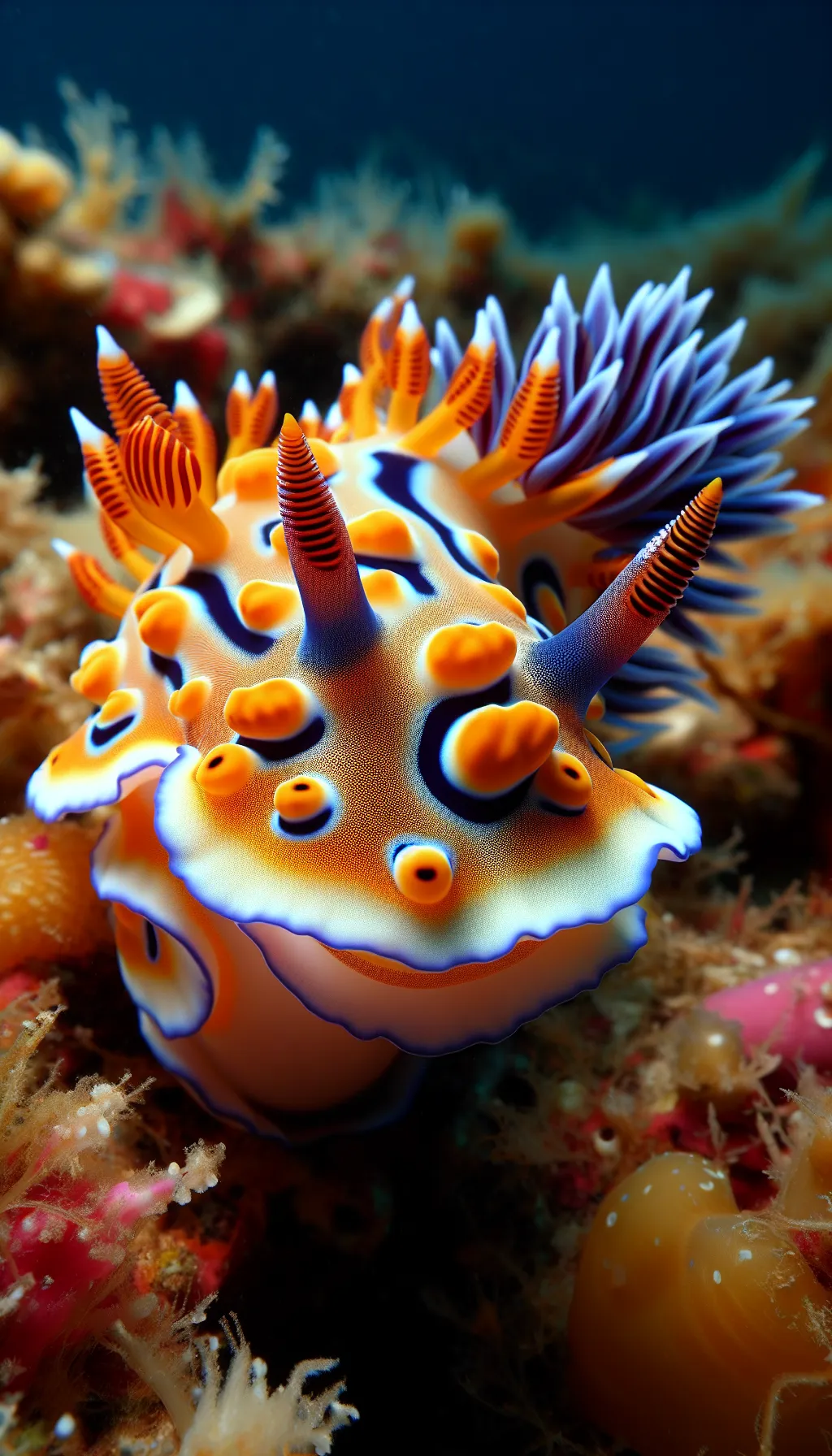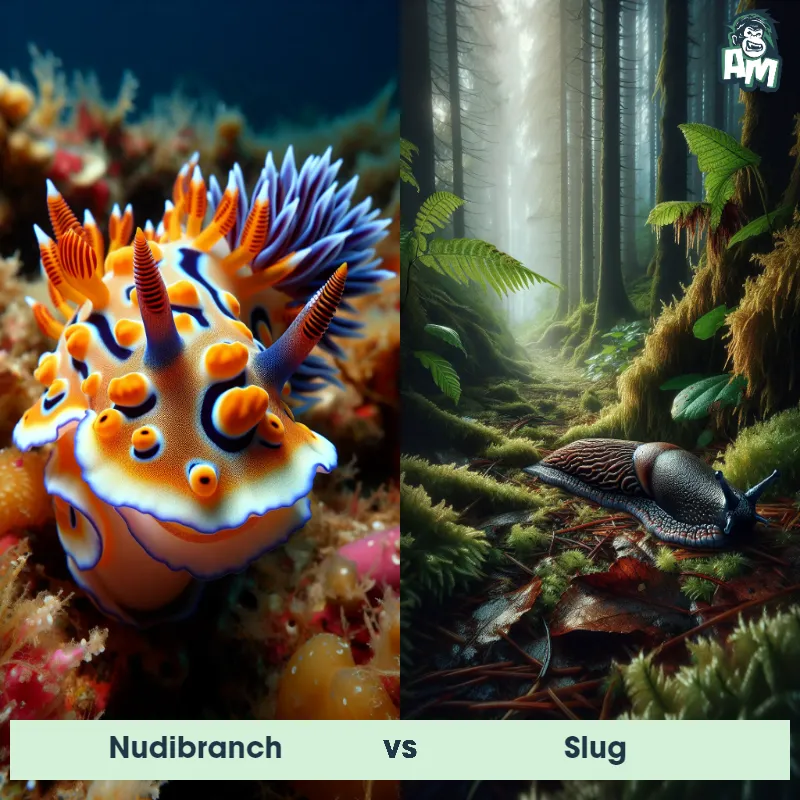The Nudibranch
The Nudibranch, also known as the sea slug, is a fascinating creature found in oceans all over the world. These soft-bodied mollusks are known for their bright and vibrant colors, making them a favorite subject for underwater photographers. Nudibranchs display a wide variety of shapes and sizes, ranging from a few centimeters to up to 30 centimeters in length. They have unique appendages and structures on their bodies, often resembling spikes, bumps, or feathery cerata. Despite their lack of a protective shell, Nudibranchs possess toxic glands in their bodies to defend themselves against predators.

| Nudibranch | |
|---|---|
| Size | 0.2 inches to 12 inches (0.5 cm to 30 cm) |
| Weight | Varies depending on species |
| Speed | 0.003 mph (0.005 km/h) |
| Key Strength | None (not known for fighting) |
| Biggest Weakness | Lack of physical defenses |
| Scientific Name | Nudibranchia |
| Family | Various families within Nudibranchia |
| Habitat | Coastal reefs and ocean floors |
| Geography | Worldwide |
| Diet | Feed on plankton, algae, and other small marine organisms |
| Lifespan | 1 years - 2 years |

The Nudibranch
The Nudibranch, also known as the sea slug, is a fascinating creature found in oceans all over the world. These soft-bodied mollusks are known for their bright and vibrant colors, making them a favorite subject for underwater photographers. Nudibranchs display a wide variety of shapes and sizes, ranging from a few centimeters to up to 30 centimeters in length. They have unique appendages and structures on their bodies, often resembling spikes, bumps, or feathery cerata. Despite their lack of a protective shell, Nudibranchs possess toxic glands in their bodies to defend themselves against predators.
Fun Fact: Nudibranchs are hermaphroditic, meaning they possess both male and female reproductive organs, allowing them to mate with any other individual they encounter in their environment.
| Nudibranch | |
|---|---|
| Size | 0.2 inches to 12 inches (0.5 cm to 30 cm) |
| Weight | Varies depending on species |
| Speed | 0.003 mph (0.005 km/h) |
| Key Strength | None (not known for fighting) |
| Biggest Weakness | Lack of physical defenses |
| Scientific Name | Nudibranchia |
| Family | Various families within Nudibranchia |
| Habitat | Coastal reefs and ocean floors |
| Geography | Worldwide |
| Diet | Feed on plankton, algae, and other small marine organisms |
| Lifespan | 1 years - 2 years |
Nudibranch Matchups
We use AI to simulate matchups between the Nudibranch and other animals. Our simulation considers size, strength, and natural predatory behaviors to determine the most likely outcome.

Can't find the Matchup you want?
Create Your Own MatchupNudibranch: Diet, Predators, Aggression, and Defensive Behaviors
What do Nudibranchs eat?
Nudibranchs are carnivorous creatures that feed primarily on sponges, cnidarians, and other invertebrates like barnacles and sea anemones. Some species have specialized diets, such as those that exclusively feed on certain types of algae or hydroids.
Do Nudibranchs have any predators?
Despite their bright and vibrant colors, Nudibranchs have many predators in their natural habitat. These include fish, crabs, sea stars, and even other Nudibranchs. Some species have developed toxic defenses to deter predators, while others rely on camouflage to blend into their surroundings.
Are Nudibranchs aggressive?
Nudibranchs are generally not considered aggressive animals. They are slow-moving creatures that primarily focus on feeding and reproduction. However, there are some species that exhibit territorial behavior towards other Nudibranchs or animals that may encroach on their feeding grounds.
Do Nudibranchs fight?
Nudibranchs are not known for engaging in physical fights like many other marine animals. Instead, they have various behavioral strategies to avoid confrontation, such as using chemical defenses or releasing toxins when threatened. Some species also have sharp appendages or spines that can be used for defense.
How do Nudibranchs defend themselves?
Nudibranchs have developed a wide range of defense mechanisms to protect themselves from predators. These include camouflage, toxic secretions, stinging cells obtained from their prey, and even the ability to release a cloud of mucus to confuse or deter attackers. Some species can also regrow lost body parts if necessary.
What is the biggest weakness of Nudibranchs in a fight?
One of the biggest weaknesses of Nudibranchs in a fight is their lack of mobility and defensive structures. While they have developed unique defenses to ward off predators, they are still vulnerable to fast-moving attackers or larger predators that can overpower them. Additionally, their bright colors can make them more visible to potential threats in their environment.
Fun Fact: Nudibranchs come in a remarkable array of colors and patterns, which serves as a defense mechanism by camouflaging them from predators or warning them of their toxicity.
Fun Fact: Some Nudibranchs have the ability to incorporate the stinging cells called nematocysts from their prey, such as the venomous tentacles of jellyfish, into their own defense system, making them even more dangerous to potential predators.











